Valvular heart disease: what does cardiovascular MRI add?
- PMID: 17762934
- PMCID: PMC3252017
- DOI: 10.1007/s00330-007-0731-x
Valvular heart disease: what does cardiovascular MRI add?
Abstract
Although ischemic heart disease remains the leading cause of cardiac-related morbidity and mortality in the industrialized countries, a growing number of mainly elderly patients will experience a problem of valvular heart disease (VHD), often requiring surgical intervention at some stage. Doppler-echocardiography is the most popular imaging modality used in the evaluation of this disease entity. It encompasses, however, some non-negligible constraints which may hamper the quality and thus the interpretation of the exam. Cardiac catheterization has been considered for a long time the reference technique in this field, however, this technique is invasive and considered far from optimal. Cardiovascular magnetic resonance imaging (MRI) is already considered an established diagnostic method for studying ventricular dimensions, function and mass. With improvement of MRI soft- and hardware, the assessment of cardiac valve function has also turned out to be fast, accurate and reproducible. This review focuses on the usefulness of MRI in the diagnosis and management of VHD, pointing out its added value in comparison with more conventional diagnostic means.
Figures
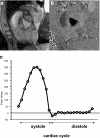

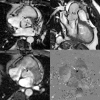
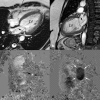
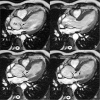



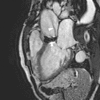
Similar articles
-
Cardiac magnetic resonance imaging in valvular heart disease.Clin Physiol Funct Imaging. 2009 Jul;29(4):229-40. doi: 10.1111/j.1475-097X.2009.00865.x. Epub 2009 Mar 11. Clin Physiol Funct Imaging. 2009. PMID: 19302226 Review.
-
Magnetic resonance imaging in valvular heart disease: clinical application and current role for patient management.J Magn Reson Imaging. 2012 Jun;35(6):1241-52. doi: 10.1002/jmri.23544. J Magn Reson Imaging. 2012. PMID: 22588991 Review.
-
[Magnetic resonance imaging in the assessment of valvular heart disease].Rev Esp Cardiol. 2011 Jul;64 Suppl 2:10-8. doi: 10.1016/j.recesp.2011.01.021. Rev Esp Cardiol. 2011. PMID: 21807283 Review. Spanish.
-
[Imaging technique and current status of valvular heart disease using cardiac MRI].Radiologe. 2013 Oct;53(10):872-9. doi: 10.1007/s00117-012-2468-z. Radiologe. 2013. PMID: 24129986 German.
-
Assessment of valve disease: qualitative and quantitative.Magn Reson Imaging Clin N Am. 2003 Feb;11(1):115-34, vii. doi: 10.1016/s1064-9689(02)00024-7. Magn Reson Imaging Clin N Am. 2003. PMID: 12797514 Review.
Cited by
-
Aortic valvular imaging with cardiovascular magnetic resonance: seeking for comprehensiveness.Br J Radiol. 2019 Sep;92(1101):20170868. doi: 10.1259/bjr.20170868. Epub 2019 Jul 18. Br J Radiol. 2019. PMID: 30277407 Free PMC article. Review.
-
The role of cardiac magnetic resonance in valvular heart disease.Methodist Debakey Cardiovasc J. 2013 Jul-Sep;9(3):142-8. doi: 10.14797/mdcj-9-3-142. Methodist Debakey Cardiovasc J. 2013. PMID: 24066197 Free PMC article. Review.
-
Comprehensive cardiac magnetic resonance imaging.J Invasive Cardiol. 2009 Jul;21(7):339-45. J Invasive Cardiol. 2009. PMID: 19571346 Free PMC article. Review. No abstract available.
-
Imaging sequences in cardiovascular magnetic resonance: current role, evolving applications, and technical challenges.Int J Cardiovasc Imaging. 2012 Dec;28(8):2027-47. doi: 10.1007/s10554-012-0038-0. Epub 2012 Mar 25. Int J Cardiovasc Imaging. 2012. PMID: 22447266 Review.
-
Noninvasive imaging of the heart and coronary arteries.Surg Clin North Am. 2009 Aug;89(4):763-80, vii. doi: 10.1016/j.suc.2009.05.007. Surg Clin North Am. 2009. PMID: 19782836 Free PMC article. Review.
References
-
- Simpson IA, Sahn DJ. Quantification of valvular regurgitation by Doppler echocardiography. Circulation. 1991;84(3 Suppl):I188–I192. - PubMed
-
- Segal J, Lerner DJ, Miller DC, Mitchell RS, Alderman EA, Popp RL. When should Doppler-determined valve area be better than the Gorlin formula?: Variation in hydraulic constants in low flow states. J Am Coll Cardiol. 1987;9:1294–1305. - PubMed
Publication types
MeSH terms
LinkOut - more resources
Full Text Sources
Medical

